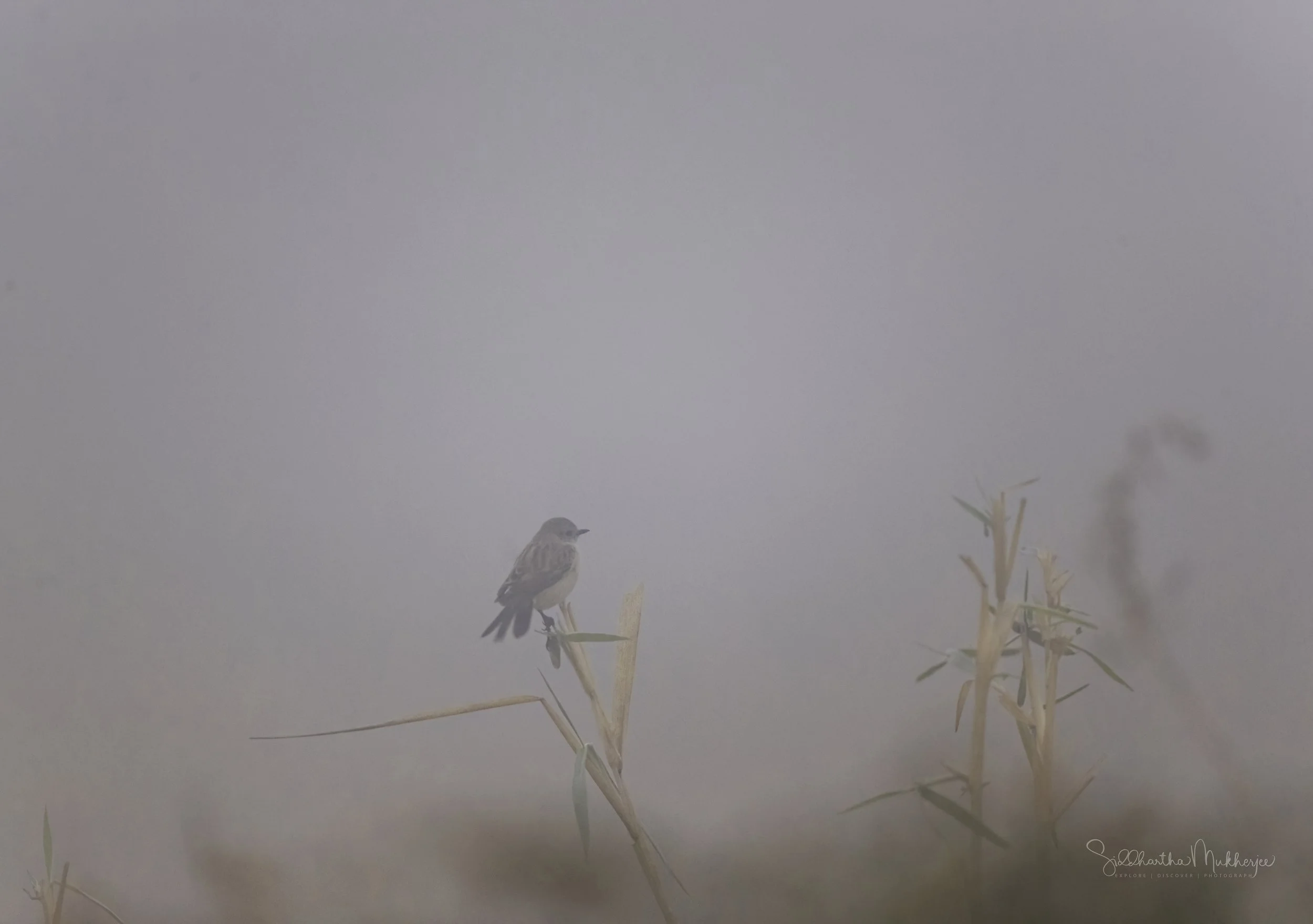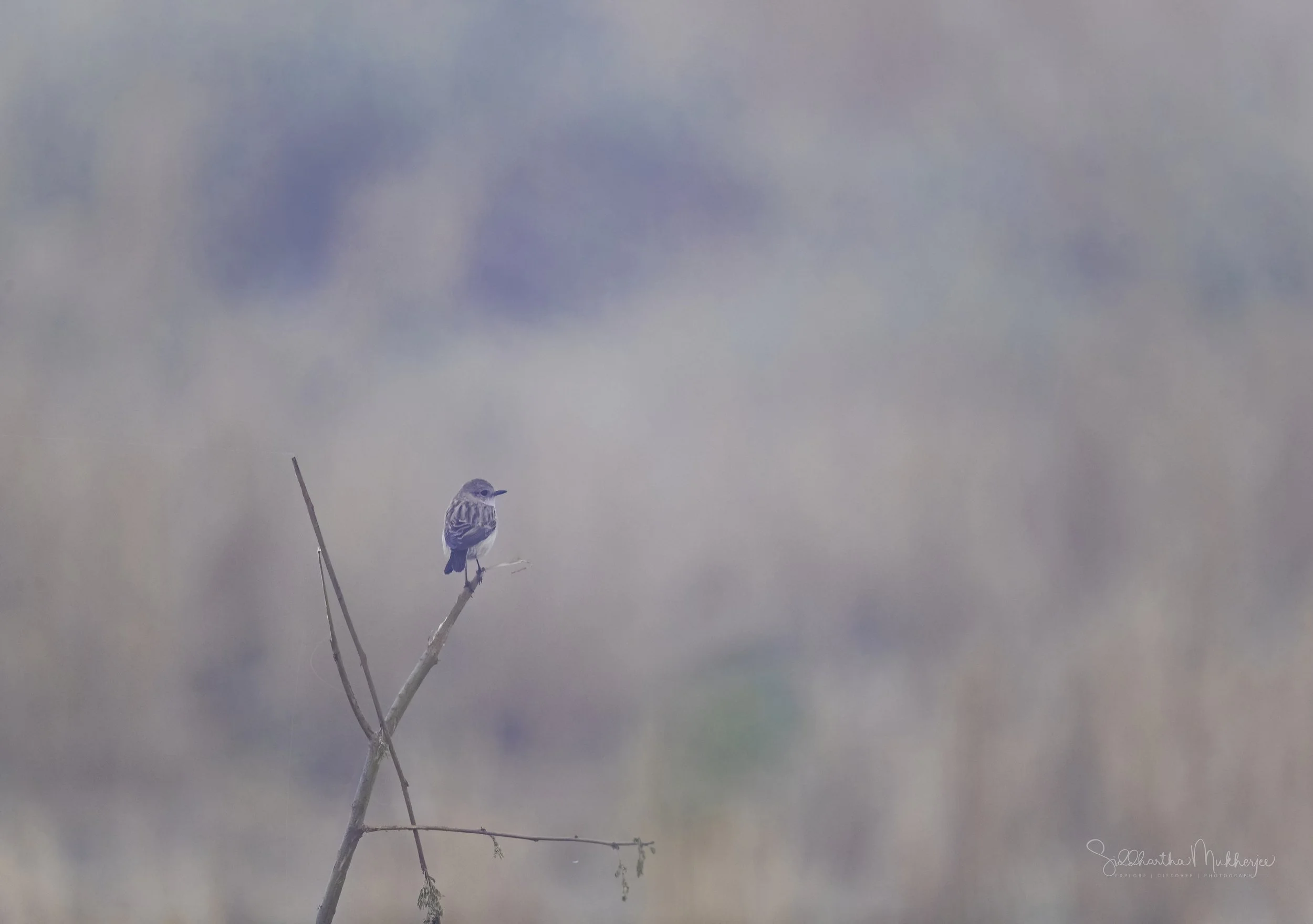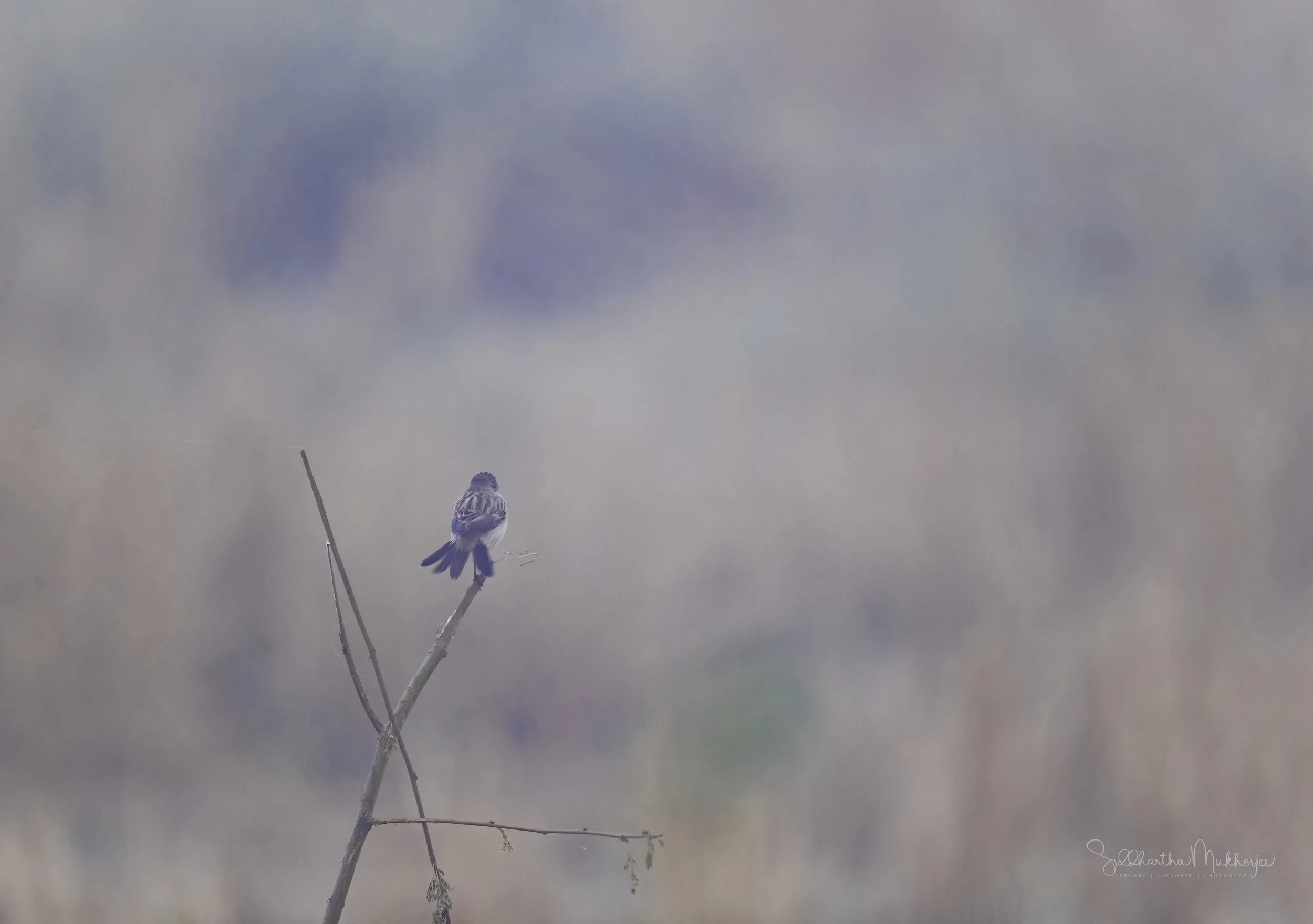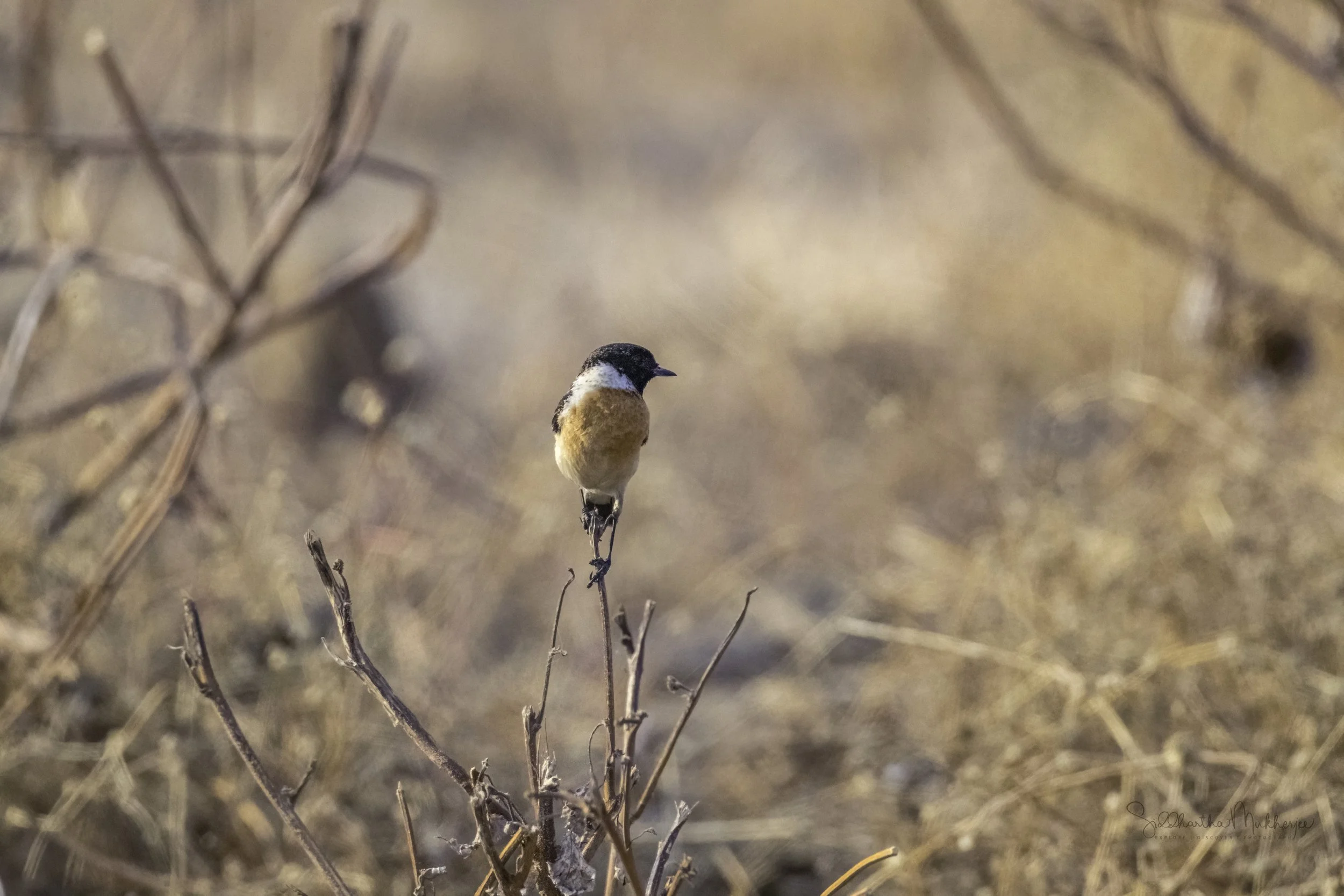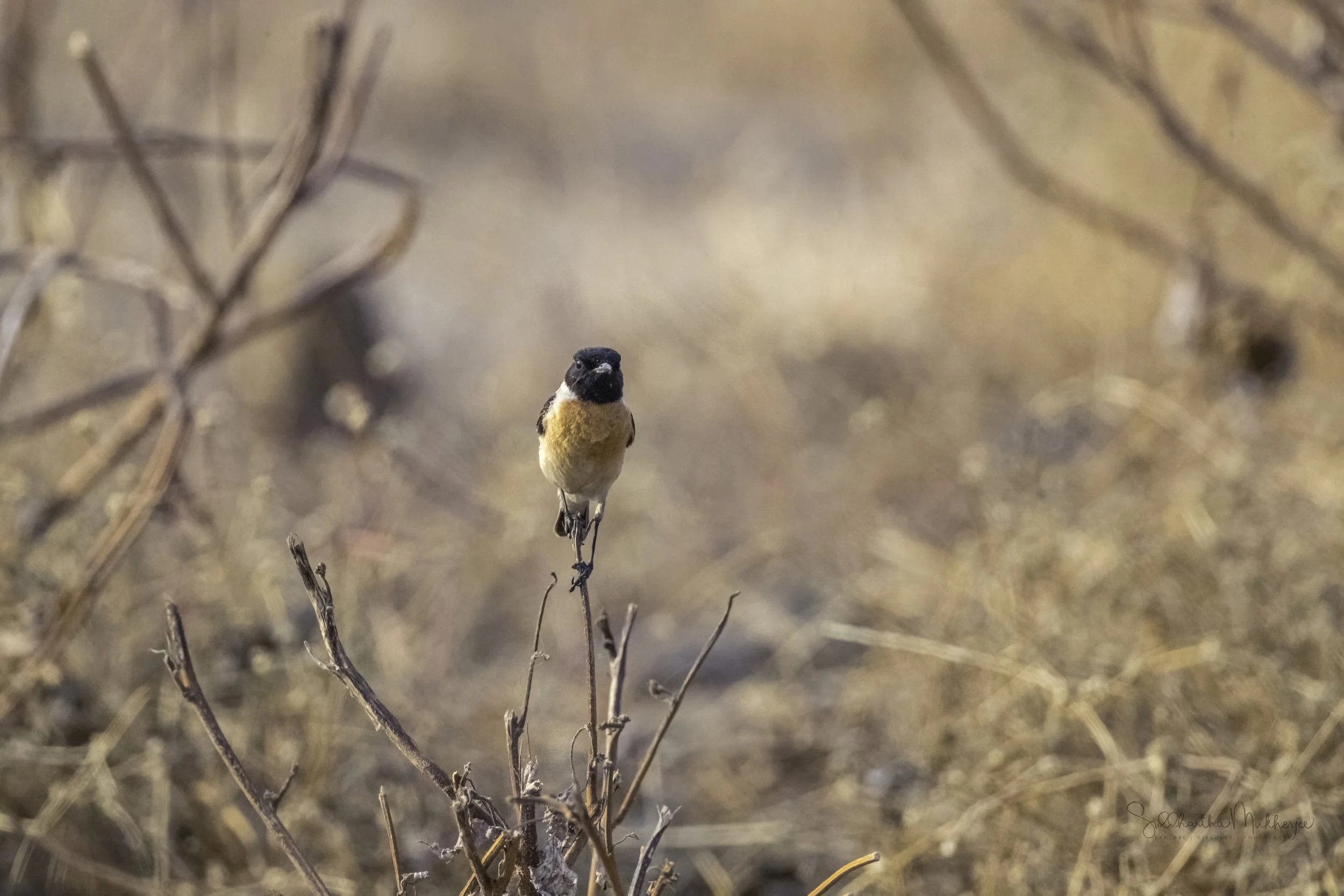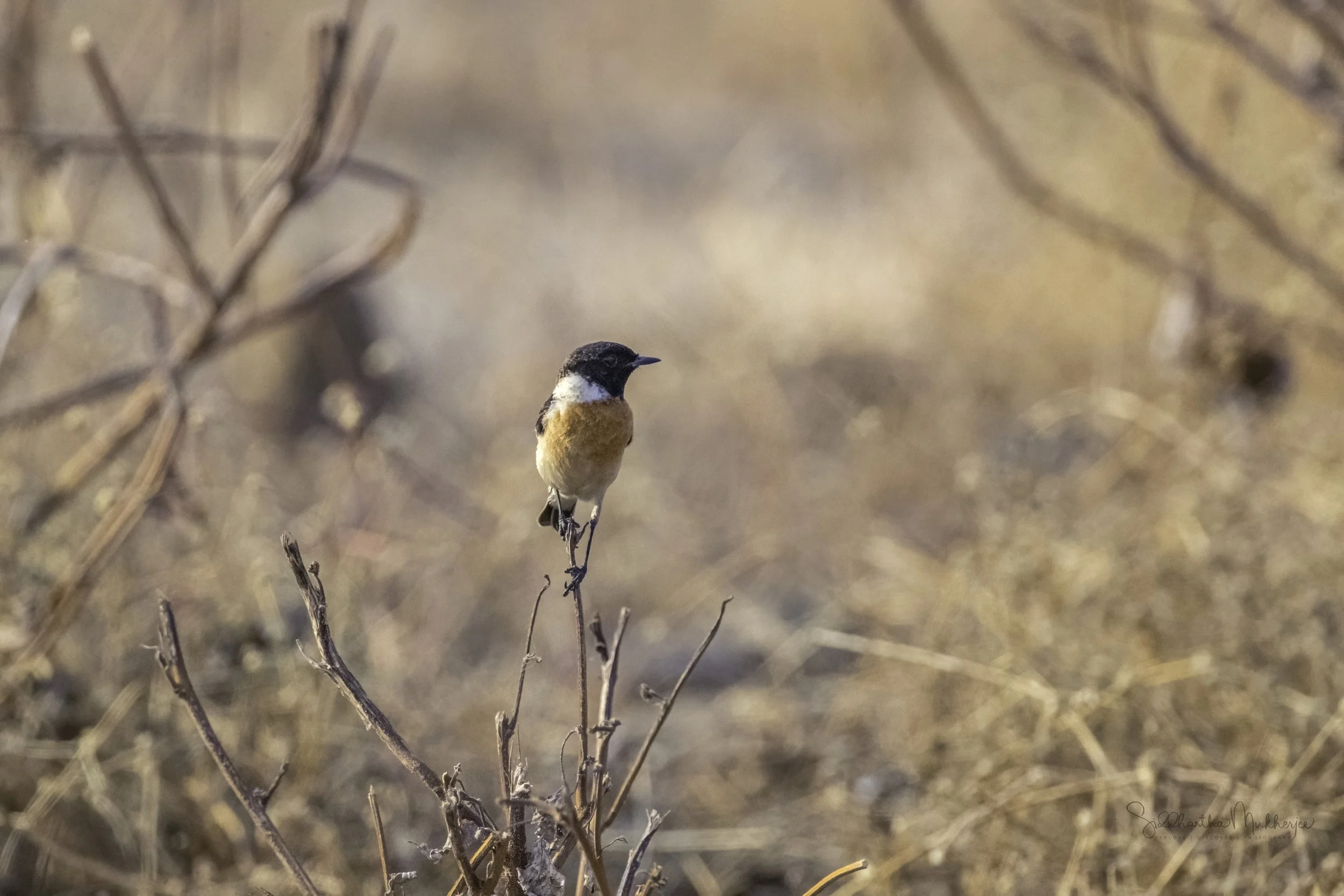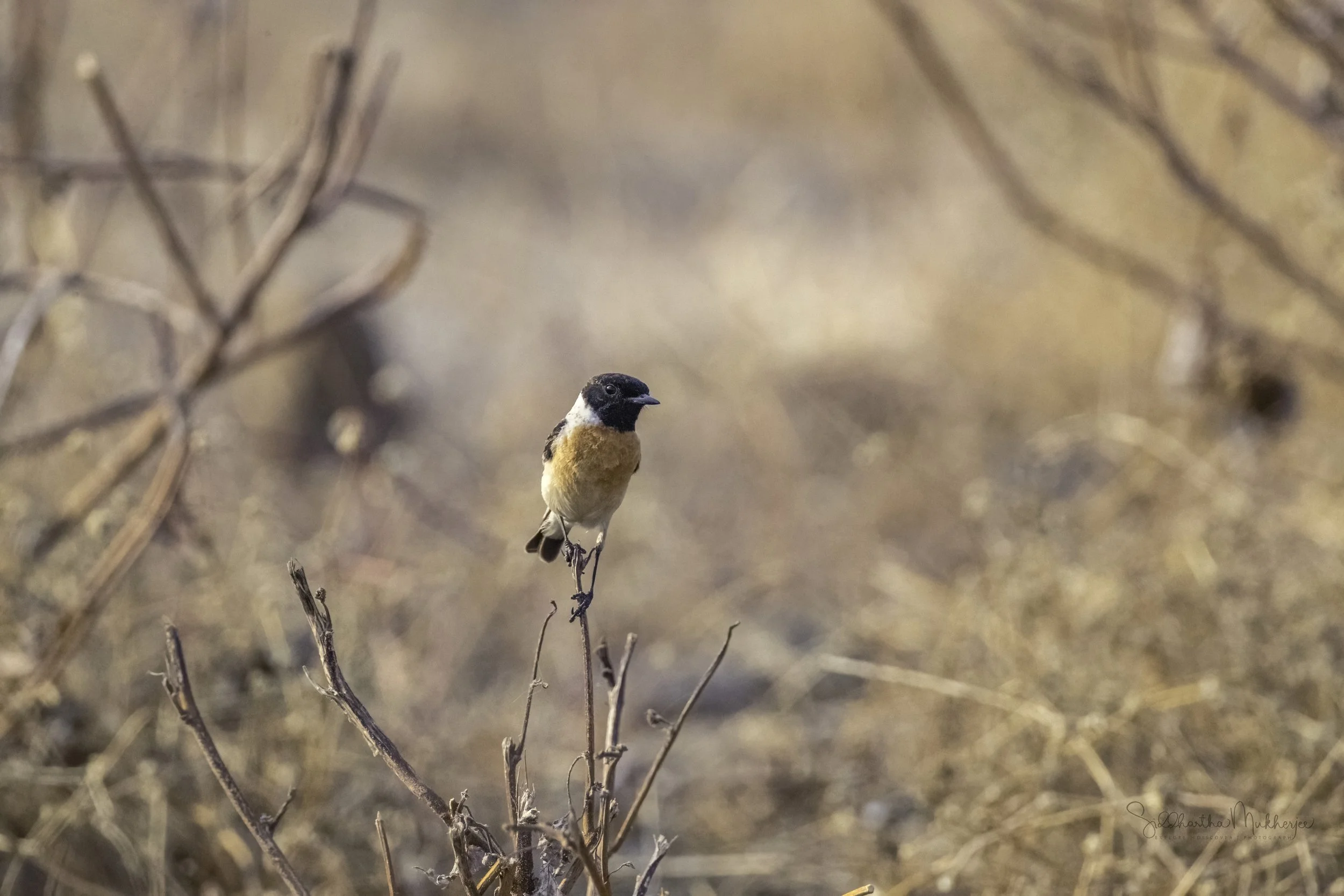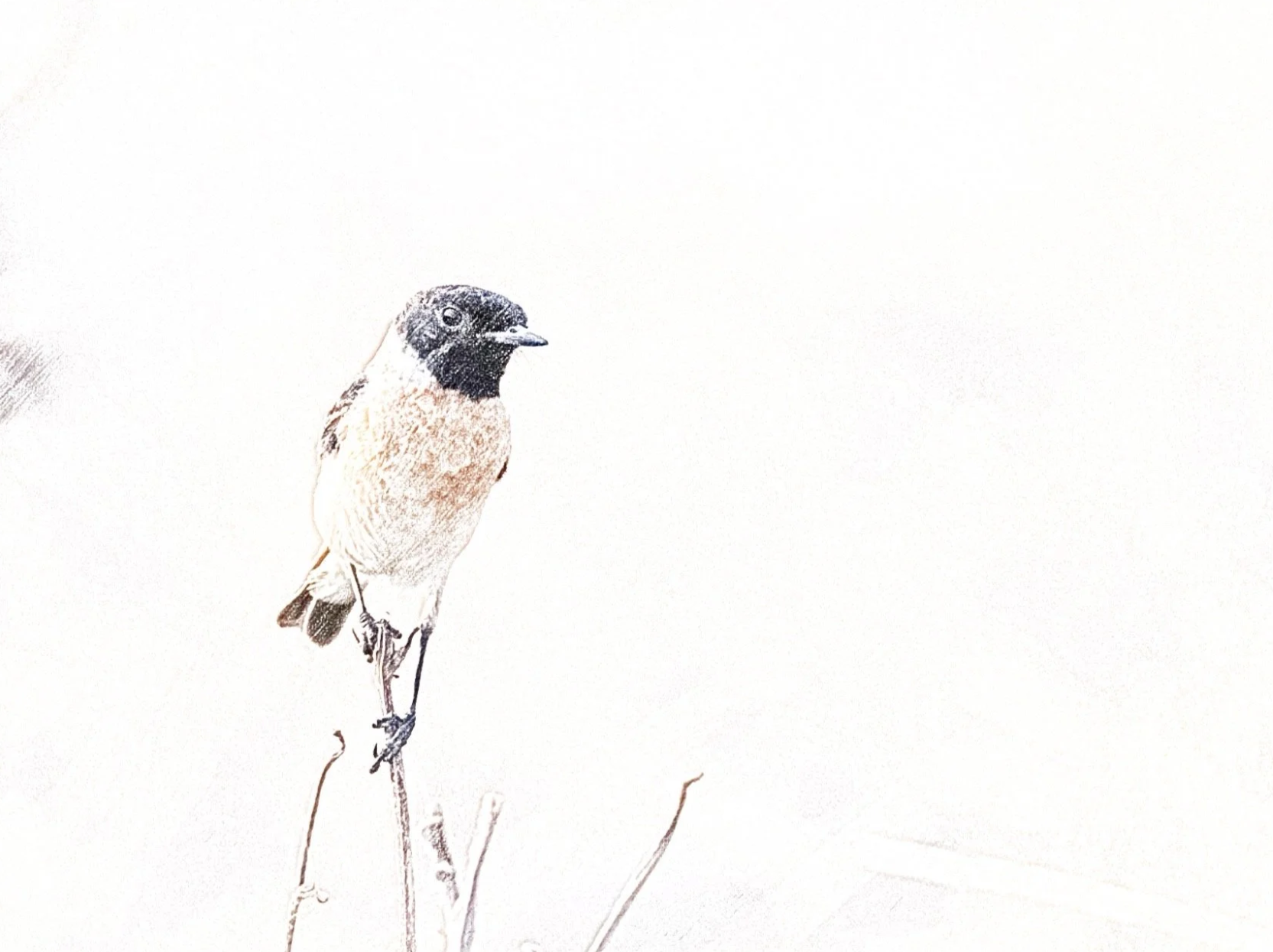Siberian Stonechat
Saxicola maurus
Manjeera Wildlife Sanctuary, Telangana
Every winter, as the vast, silent landscapes of Siberia and temperate Asia surrender to ice and snow, a remarkable natural phenomenon unfolds: a mass migration of millions of birds seeking survival in warmer climes. Among the most resilient of these avian voyagers is the Siberian Stonechat (Saxicola maurus), a tiny bird that flies thousands of kilometers to the Indian subcontinent. In Telangana, this little flycatcher becomes a familiar, welcome sight during the cooler months, transforming open scrublands and wetland margins into temporary winter homes. The very name "stonechat" is derived from its distinctive call—a sound precisely like two small stones being tapped together (chack-chack)—a sound that, for many birdwatchers in India, signifies the true arrival of winter. This blog explores the natural history of this charismatic visitor, offering detailed insights into its physical characteristics, unique behaviours, incredible migration patterns, and where bird enthusiasts in Telangana can observe this enduring symbol of resilience.
Telangana is a state in southern India with Hyderabad as its capital. Hyderabad is home to the Charminar, a 16th-century mosque with 4 arches supporting 4 towering minarets. The monument overlooks the city's long-running Laad Bazaar. Laad Bazaar or Choodi Bazaar is a very old market popular for bangles located on one of the four main roads that branch out from the historic Charminar. “Laad” meaning lacquer is used to make bangles, on which artificial diamonds are studded. In this 1-kilometre (0.62 mi)-long shopping strip, most of the shops sell bangles, sarees, wedding related items, and imitation jewellery. Once the seat of the Qutb Shahi dynasty, the sprawling Golconda Fort is a former diamond-trading center.
Located in the central stretch of the Deccan Plateau, Telangana has sub-tropical climate and the terrain consists mostly of hills, mountain ranges, and thick dense forests covering an area of 27,292 km². The annual rainfall ranges between 1,100 mm to 1,200 mm and the annual temperature varies from 15 C to 45 C. The State is drained by a number of rivers which include Godavari and Krishna.
Telangana is endowed with rich diversity of flora and fauna. It has dense teak forests on the northern part along the banks of river Godavari. As per the Champion & Seth Classification of Forest Types (1968), the forests in Telangana belong to three Forest Type Groups, which are further divided into 12 Forest Types. The State Government has taken up a massive greening programme, 'Telangana Ku Harita Haram' in the State to plant and protect 230 crore seedlings over a period of 4 years. This initiative aims at achieving the twin objectives of increasing the forest cover and reduce pressure on the existing forest resources, through massive community participation by Vana Samrakshna Samithis (VSS) and Eco-Development Committees (EDCs) in Protected Areas and Watershed Development Committees in the Watershed areas. Recorded Forest Area (RFA) in the State is 26,904 km² of which 20,353 km² is Reserved Forest, 5,939 km² is Protected Forest and 612 km² is Unclassed Forests. In Telangana, during the period 1st January 2015 to 5th February 2019, a total of 9,420 hectares of forest land was diverted for non-forestry purposes under the Forest Conservation Act, 1980 (MoEF & CC, 2019). As per the information received from the State during that last two years, 12,730 ha of plantations including avenue plantations in the State.
Three National Parks and nine Wildlife Sanctuaries, which include the Amrabad Tiger Reserve, Kawal Tiger Reserve, Pocharam Wildlife Sanctuary, Etunagaram Wildlife Sanctuary, Kinnerasani Wildlife Sanctuary, Manjira Wildlife Sanctuary and Pakhal Wildlife Sanctuary, constitute the Protected Area network of the State covering 5.08% of its geographical area.
Siberian Stonechat - Male
Manjeera Wildlife Sanctuary - A Mosaic of Ideal Habitats
For the small, resilient Siberian Stonechat, Telangana's varied landscapes offer a crucial winter haven, providing the ideal mix of open space, low vegetation, and abundant insect life necessary for survival after their arduous migration from temperate Asia. The sanctuary, located along a 36 km stretch of the Manjeera River in the Sangareddy district, perfectly caters to the specific habitat needs of this tiny, active bird and is an essential stopover and wintering site for many other migratory birds. The key to its appeal for the Siberian Stonechat lies in its diverse, specific micro-habitats:
Marshy Fringes and Reeds: The reservoir features nine small islands with extensive marshy fringes. These areas, rich with emergent vegetation like Typha (commonly known as cattails, bulrushes or reedmace) and Ipomoea species (common names include morning glory, water convolvulus or water spinach, sweet potato, bindweed, moonflower, etc), are prime real estate for the stonechat. The tall, sturdy reeds provide the perfect exposed perches from which the birds can scan the water margins and surrounding marshland for insects using their signature "perch-and-pounce" hunting method.
Grasslands and Scrubland: The sanctuary also encompasses areas of dry savannah-type vegetation, including various grasses like Cynodon dactylon and Heteropogon contortus, and scattered scrub species such as Acacia and Prosopis juliflora. These open, grassy areas with low bushes are exactly what the stonechat prefers, offering both cover and numerous low vantage points for foraging.
Agricultural Lands: Surveys within the sanctuary complex have found that the agricultural lands surrounding the main water body are also heavily utilized by the stonechats. Fallow fields and weed-covered areas provide rich sources of insects and spiders during the winter months.
The availability of both wetland margins and drier scrubland/agricultural zones creates a rich mosaic that ensures a year-round supply of the insects and invertebrates that make up the stonechat's diet.
Similar Habitats Across Telangana
The Siberian Stonechat is widespread across Telangana in locations that mirror the open, scrubby, and often wet-edged conditions found at Manjeera. These areas share key characteristics:
Ameenpur Lake & Nallagandla Lake: These urban lakes and others around the Hyderabad area attract stonechats to their margins. The combination of open water, surrounding grassy patches, and low scrub provides ample opportunity for them to hunt from low perches. These lakes face significant threats primarily driven by rapid urbanization and development projects, leading to severe encroachment, pollution, and a decline in biodiversity. Key threats include: Shrinking Lake Area, Illegal Construction, Blocked Inflow Channels, Construction Debris Dumping, Untreated Sewage Industrial Effluents, Eutrophication, Agricultural Runoff. The impact on Biodiversity and Ecosystem can be seen in the decline in wildlife and loss of function - meaning they lose their natural functions, such as groundwater recharge and flood control, making surrounding residential areas more vulnerable to flooding during heavy rains. There is a lack of Effective Management - Inadequate Enforcement & Garbage and Tourism Waste
Narsapur Forest Area: While the core forest is dense, the peripheral clearings and scrubland edges around Narsapur offer the open habitat the stonechat requires. They avoid dense woodland, preferring the sunlit areas with scattered bushes. But this vital green lung near the increasingly urbanized Hyderabad metropolitan region, faces several significant threats that endanger its rich biodiversity and ecological functions. Key threats include: Deforestation and Habitat Destruction which include infrastructure projects like the proposed widening of NH 765D (part of the Hyderabad ORR network), requiring the diversion of forest land & the felling of trees, directly reducing the forest cover. Urbanization and Encroachment like the proposed Waste Management Facilities which will damage the ecosystem, introduce pollutants, attracting large bird populations which will pose a threat to aircraft from the nearby Air Force Academy, and negatively impact the surrounding communities. Illegal activities and resource exploitation like illegal quarrying and sand mining, illegal logging and tree felling and other unauthorized activities like cockfighting held in the remote parts of the forest to evade authorities, which disturb wildlife and introduce waste. There are also the usual Tourism Development and Management Issues like unsustainable tourism including increased waste, human disturbance, and potential construction within sensitive areas like the lake and a lack of clear boundaries and management makes the forest vulnerable to land use changes and encroachments.
There are also broader environmental and climate threats like Pollution. The Narsapur area is already burdened by pollution from numerous pharmaceutical companies nearby. Adding a large dump yard or increased traffic from road expansion would further degrade the soil, air, and water quality. Forests weakened by human disturbances are less resilient to the effects of climate change, such as increased fire risks and changing weather patterns. These threats are pushing the Narsapur Forest area towards ecological degradation, impacting its vital role as a carbon sink and a biodiversity hub for the Hyderabad metropolitan region.
Lower Manair Dam, Karimnagar: Similar to Manjeera, the dam and its extensive reservoir create vast water margins and open areas that become ideal wintering spots for various migratory birds, including stonechats.
General Fallow & Cultivated Land: Beyond designated sanctuaries, these birds are commonly found across the state wherever there are open fields, pastures, and uncultivated land with weeds and low vegetation, particularly during the post-monsoon and winter seasons when insect populations are high.
The key takeaway for birdwatchers in Telangana is that the Siberian Stonechat thrives not in dense forests, but in these open, often sun-drenched, "edge" habitats. They are territorial in winter, and if you find a suitable patch of tall grass or a reedy bank, you are highly likely to spot this tiny, flicking migratory bird using a low perch as its winter throne.
‡‡‡‡‡
For a print of the beautiful birds from my various sojourns click on the button below to read my process and order a limited edition canvas from the catalog.
Siberian Stonechat - Female
Siberian Stonechat
The Siberian Stonechat or Asian stonechat (Saxicola maurus) is a recently validated species of the Old World Flycatcher family (Muscicapidae). Like the other thrush-like flycatchers, it was often placed in the Turdidae in the past. It breeds in the East Palearctic including in eastern most Europe and winters in the Old World tropics.. Despite its long journey, it remains a diminutive creature:
Size: They typically measure around 12.5–14 cm in length.
Weight: Weighing a mere 13 to 17 grams, this bird's ability to migrate such vast distances is truly astonishing.
The plumage of the Siberian Stonechat is sexually dimorphic, meaning males and females look distinctly different, especially during the breeding season. A breeding male is unmistakable: a jet-black head, a broad white half-collar or neck patch, a large white patch on its wings, and a vibrant rusty-red or orange breast. During the winter (non-breeding) season in India, the male's plumage becomes patchier and slightly duller, though black feather bases on the head and a larger white wing patch typically remain visible, distinguishing it from related species. The female is more camouflaged, with a predominantly streaky brown back and head, a less conspicuous pale neck patch, and duller buffish or pinkish-yellow underparts.
Identifying Behaviours and Diet: The "Perch-and-Pounce" Hunter
The most reliable way to spot a Siberian Stonechat is to look for its characteristic behavior and habitat choice. It is an active, restless bird that rarely stays in one spot for long.
The Upright Posture & Flicking: They maintain a very upright posture while perched on exposed vantage points, such as tall grass stems, small bushes, or fence wires. They frequently flick their wings and tail, a behavior used perhaps for balance, display, or to flush out insects.
Perch-and-Pounce: This is their signature hunting style. They sit patiently on a low perch, scanning the ground for insects. Once prey (like beetles, grasshoppers, or spiders) is spotted, the bird quickly drops to the ground to capture it, often returning to the same or a nearby perch within moments.
Diet: They are primarily insectivorous, though they may occasionally supplement their diet with small seeds and berries in winter when insects are scarce.
Twenty-four subspecies are recognized.
Siberian Stonechat (Caspian) Saxicola maurus hemprichii - Distributed in E Ukraine (lower R Don) and E Crimea, E to Kalmykiya plains and NE Volga Delta area, S to N slopes of Caucasus and N Azerbaijan; non-breeding NE Africa.
Siberian Stonechat (Siberian)Saxicola maurus variegatus - Distributed in NE Turkey, Transcaucasia and NW and SW Iran; status in Azerbaijan unclear; non-breeding SW Asia and NE Africa.
Saxicola maurus maurus - Distributed in N and E European Russia E to Mongolia and E Tien Shan, S to NE Iran, S Turkmenistan and W Pakistan; has bred in E Finland; non-breeding SW and S Asia.
Saxicola maurus indicus - Distributed in the Himalayas from Kashmir E to NE India; non-breeding Pakistan and India.
Siberian Stonechat (Przevalski's) Saxicola maurus przewalskii - Distributed in the Tibetan Plateau E to C China (NE Qinghai E to Shanxi and W Hubei, S to Yunnan, Guizhou and Guangxi), S to NE Myanmar and N Indochina; non-breeding N and NE India E to SE China and SE Asia.
Hybridization
Whinchat x Siberian Stonechat (hybrid) Saxicola rubetra x maurus
The Siberian Stonechat is a classic long-distance migratory species. Its breeding range covers vast areas of temperate Asia, from as far north as latitude 71°N in Siberia south to the Himalayas and eastern Turkey. These birds begin their southward migration as early as August and September to escape the harsh continental winters of their breeding grounds. They follow major aerial routes, often crossing the formidable Himalayan corridor to reach their tropical wintering grounds, which stretch across India, Southeast Asia, and even parts of Northeast Africa. They typically arrive in Telangana around late September or October and stay until the end of the winter season, usually departing by March or April. This journey is a remarkable feat of endurance, covering thousands of kilometers over several weeks.
During their stay in India, they seek out open habitats that mimic their breeding grounds' clearings. They are commonly found in:
Open rough scrubland and grasslands.
Fallow fields and agricultural areas.
Wetland margins with tall grasses and reeds.
The Siberian Stonechat is a regular and widespread winter visitor across Telangana's diverse landscapes. Bird enthusiasts have frequently recorded their presence in several key locations, highlighting the state's importance as a crucial wintering ground for these tiny globe-trotters:
Manjeera Wildlife Sanctuary: The extensive marshy fringes and tall grasses surrounding the reservoir provide ideal foraging habitats for this insectivore.
Ammavaripeta Lake Region (Chintapalli Lake): This region and its surrounding agricultural areas are known wintering spots, utilizing lake margins and open fields for hunting and perching. Also known locally as Chintapalli Lake, this offers a highly suitable winter habitat for migratory birds like the Siberian Stonechat, primarily because of its open landscapes, wetland margins, and abundant insect life. These features mimic the preferred habitats of the species across their wider wintering range in India.
The habitat around the Ammavaripeta Lake is characterized by an intersection of water body dynamics and surrounding terrestrial environments. The lake is one of the few relatively unpolluted lakes in the region, which supports diverse aquatic life. The shallow, marshy fringes with reeds and tall grasses provide ideal foraging grounds. The area around the lake is interspersed with agricultural lands and fallow fields. These cultivated and uncultivated lands provide extensive open spaces with low vegetation, which is the exact habitat preference of the Siberian Stonechat. The surrounding area often features low-nutrient soils, supporting the growth of specific grass species and low-lying shrubs rather than dense forests. This scrubby, open environment is crucial for the stonechat. Like other regions in Telangana (e.g., around Ameenpur Lake), the area has undulating terrain with scattered rocky outcrops and small bushes. These natural features serve as the exposed perches that stonechats rely on for hunting and scanning for threats.
The specific environmental conditions at the Ammavaripeta Lake make it a magnet for Siberian Stonechats during the winter: The healthy wetland ecosystem and surrounding agricultural areas support a high density of insects (beetles, grasshoppers, spiders) which are the primary diet of the insectivorous stonechat. The birds' characteristic hunting style involves perching on a prominent low feature (grass stem, small bush, low wire) and darting down to catch prey on the ground. The open, scrubby landscape of the Ammavaripeta region is perfect for this behavior, offering numerous look-out points. Siberian Stonechats avoid densely vegetated areas and closed woodlands, preferring sunlit areas with scattered bushes. The open nature of the lake periphery aligns perfectly with this preference. The proximity to the lake ensures consistent access to water, and the damp soil near the margins may also support a higher concentration of prey items. The consistent flow of migratory birds to the lake suggests it is a traditional and reliable wintering ground, indicating a stable and suitable habitat over time.
In essence, the mosaic of wetland margins, open grasslands, and low scrub at Ammavaripeta Lake creates the ideal wintering conditions for the Siberian Stonechat to successfully forage, rest, and survive the cold months before their long journey back to Asia in the spring.
Narsapur Forest Area: The forest peripheries, clearings, and open fields near this area frequently host stonechats during the winter season.
Ameenpur Lake & Nallagandla Lake: These popular birding spots around Hyderabad offer excellent opportunities to see them perching on reeds or low fences around the water bodies.
Lower Manair Dam, Karimnagar: Regions around large water bodies with surrounding open scrub attract these migrants in good numbers.
Spotting a Siberian Stonechat is more than just adding a species to a checklist; it is witnessing a triumph of nature's engineering — a 15-gram bird that defies distance and climate to find a safe haven right here in Telangana. However, its future is intertwined with the fate of global climate. As climate change continues to alter seasonal patterns and habitats, this tiny migratory bird faces an uncertain future. By understanding the intricate details of its migration and the threats it faces, we can appreciate the importance of conservation efforts and climate action to ensure that this charming winter visitor continues to grace the landscapes of Telangana for generations to come. Though it is not considered a distinct species by the IUCN, it is widespread and common and would not be considered a threatened species.
‡‡‡‡‡
Related Posts



